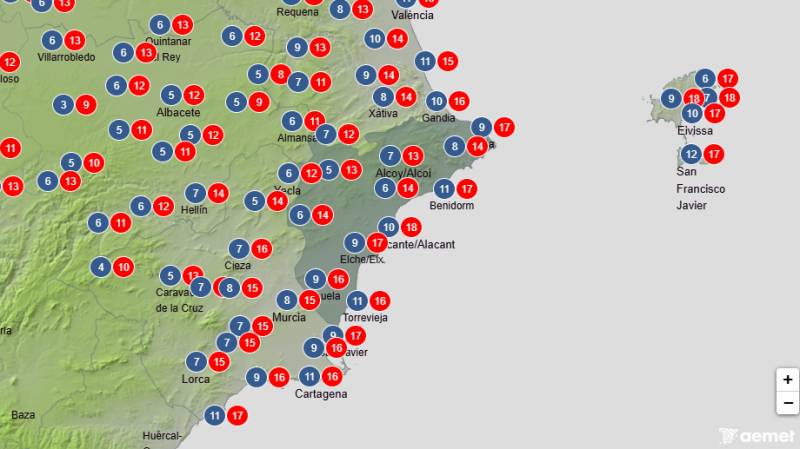

Guidelines for submitting articles to Mazarron Murcia
Hello, and thank you for choosing Mazarron Murcia to publicise your organisation’s info or event.
Mazarron Murcia is a website set up by Murcia Today specifically for residents of the urbanisation in Southwest Murcia, providing news and information on what’s happening in the local area, which is the largest English-speaking expat area in the Region of Murcia.
When submitting text to be included on Mazarron Murcia, please abide by the following guidelines so we can upload your article as swiftly as possible:
Send an email to editor@spaintodayonline.com or contact@murciatoday.com
Attach the information in a Word Document or Google Doc
Include all relevant points, including:
Who is the organisation running the event?
Where is it happening?
When?
How much does it cost?
Is it necessary to book beforehand, or can people just show up on the day?
…but try not to exceed 300 words
Also attach a photo to illustrate your article, no more than 100kb

Colegio and Church of Santo Domingo, Orihuela
Santo Domingo Is a Spanish National Heritage site
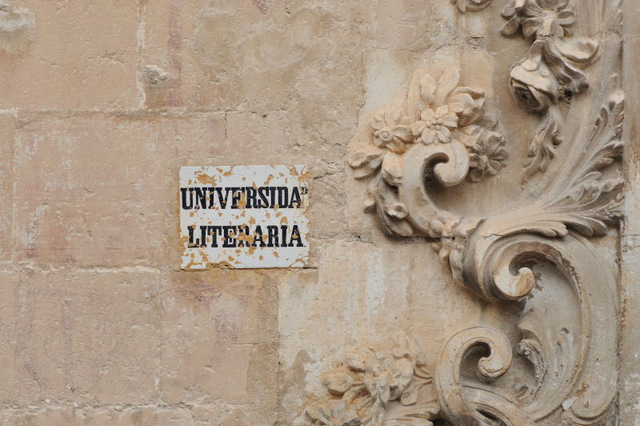 This huge building was founded as a monastery with a school annexed in the early sixteenth century, and soon became a university, a status which it maintained until 1824. It was declared a monument to fine art by Queen Isabel II in the 19th century, and is now a Spanish National Heritage site.
This huge building was founded as a monastery with a school annexed in the early sixteenth century, and soon became a university, a status which it maintained until 1824. It was declared a monument to fine art by Queen Isabel II in the 19th century, and is now a Spanish National Heritage site.
The building is over 120 metres long and occupies over 18,000 square metres, making it one of the largest in the Comunitat Valenciana. The monastery which it was built to house was founded in 1512 by Cardinal Fernando de 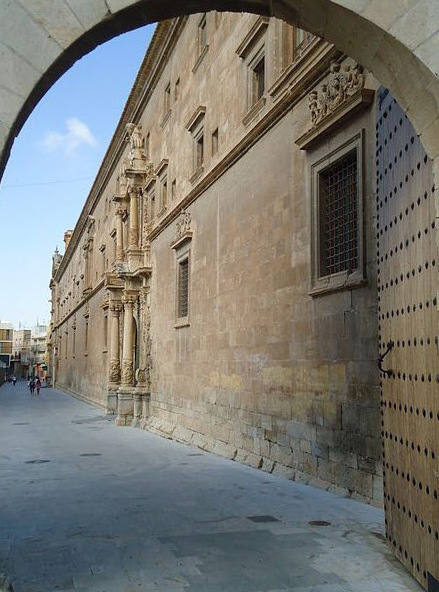 Loazes, who also created the “Colegio del Patriarca” in 1547. He offered the running of the school to the order of Santo Domingo, who gratefully accepted.
Loazes, who also created the “Colegio del Patriarca” in 1547. He offered the running of the school to the order of Santo Domingo, who gratefully accepted.
In 1552 Pope Julius III upgraded the educational establishment from a college to a university, and in 1569 Pope Pius IV made it a “Pontifical University”. The word “Royal” was added to the official title in 1646 by Felipe IV, and although this university closed down in 1824 in the 21st century is now home to university studies once again, being used by the Miguel Hernández University.
Among the highlights in its long history, Santo Domingo was the home of the first national public library in Spain in the 16th century, which is now known as the Fernando de Loazes state public library.
 The building now houses a private primary and secondary school, and visitors may find the tranquility suddenly interrupted by nosiy children as morning break or lunch begins!
The building now houses a private primary and secondary school, and visitors may find the tranquility suddenly interrupted by nosiy children as morning break or lunch begins!
The main façade, on the southern side of the building, is largely plain, interrupted only by a few windows and the three doors. The “Portada de la Iglesia” was completed in 1561 by Juan de Inglés and features Corinthian columns, while the “Portada del Convento” consists of a three-level archway showing the three classical styles.
The large baroque “Portada de la Universidad” dates from the early 18th century, and was built by Pedro Juan Codoñer, who chose to adorn the top of the arch with the allegorical figure of Wisdom.
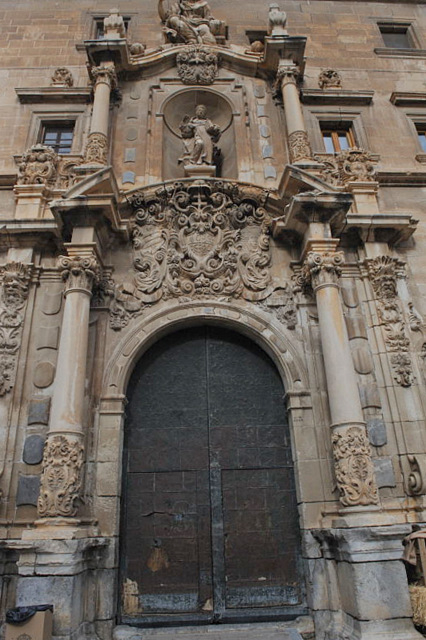 The monastery cloister was built in the early 17th century, and features two levels of arches. On the lower level the arches are supported by short pillars, while above them the arches of the upper layer are set on Ionic columns. The upper galleries were closed in during the 18th century.
The monastery cloister was built in the early 17th century, and features two levels of arches. On the lower level the arches are supported by short pillars, while above them the arches of the upper layer are set on Ionic columns. The upper galleries were closed in during the 18th century.
The stairway leading up from the monastery cloister to the university cloister is an architectural tour de force, being attached only to the wall, rather than having support from below.
The university cloister was built between 1727 and 1737, and like its counterpart in the monastery it consists of two levels of semi-circular arches. The detailed heraldic decoration above the arches includes the coats of arms of Spain, Calatrava (one of the most important noble families in Orihuela’s history) and the papacy.
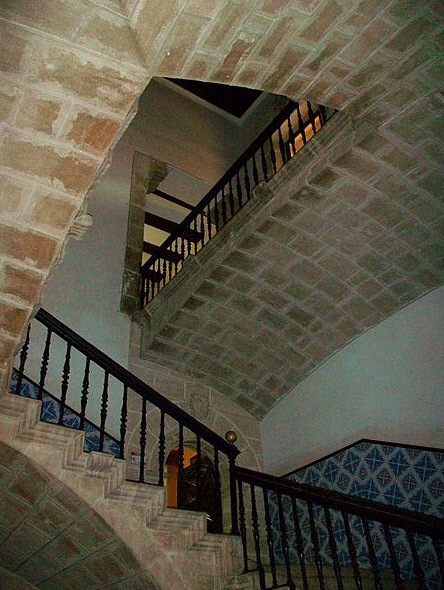 The refectory of the old monastery contains 16th century Gothic ribbing and an 18th-century Valencia-style tiled floor which is revered as one of the finest examples of its kind.
The refectory of the old monastery contains 16th century Gothic ribbing and an 18th-century Valencia-style tiled floor which is revered as one of the finest examples of its kind.
The sacristy door dates from the latter part of the 16th century, and features a triumphal arch, above which is a small shrine.
The church
If the whole of Santo Domingo is a feast of architecture and decoration, the church is without doubt the highlight. The decorations are sumptuous, and the effect of the whole interior is quite overwhelming: while it may not be to 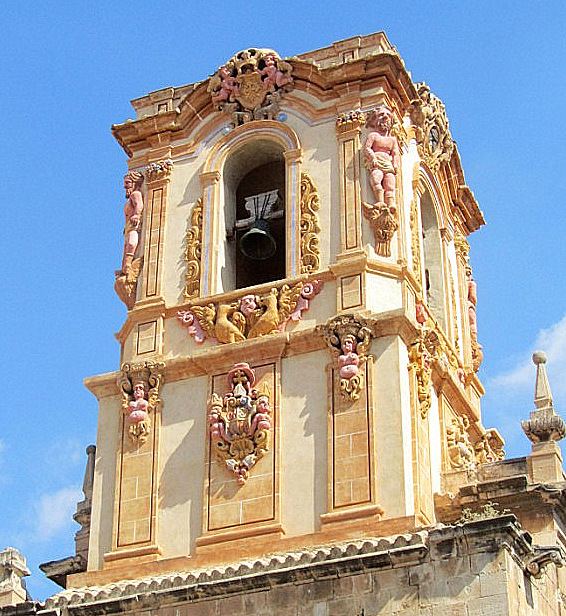 everyone’s taste, there is no disputing the fact that it is utterly spectacular.
everyone’s taste, there is no disputing the fact that it is utterly spectacular.
The bare architectural facts are that the church has a barrel vault ceiling over its only nave, and side chapels between the main pillars, but the importance of this building lies in the visual impact of the interior decoration rather than the structural details. This decoration dates from the late 17th and early 18th centuries, and contains works by various artists, the most important contributions coming from Bartolomé Albert, who also painted and gold-plated the ceiling.
Photography is not allowed unfortunately, hence the lack of images of what is undoubtedly the highlight of Orihuela.
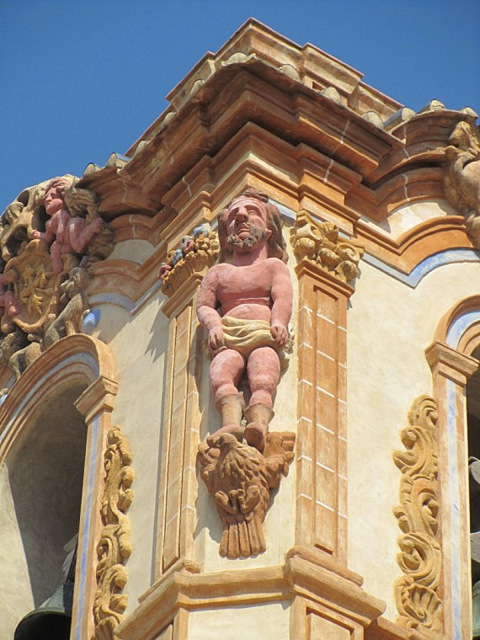 The organ is one of the many of which Orihuela is so proud, and was first used in 1701. The casing is a fine example of the baroque carving of the kingdom of Valencia.
The organ is one of the many of which Orihuela is so proud, and was first used in 1701. The casing is a fine example of the baroque carving of the kingdom of Valencia.
The tower is, from a distance, a striking, rather strange-looking structure, and from closer up it is stranger still!
It dates back to the middle of the 18th century, when it replaced a previous Renaissance structure, and if it seems very square in design this is because the dome collapsed in the nineteenth century, leaving it with a somewhat sawn-off appearance.
Perhaps the most unusual feature, though, is not its shape but the part-grotesque, part-comic sculpted figures which are highlighted in brick red on all four sides of it. Some of these figures depict angels while others more 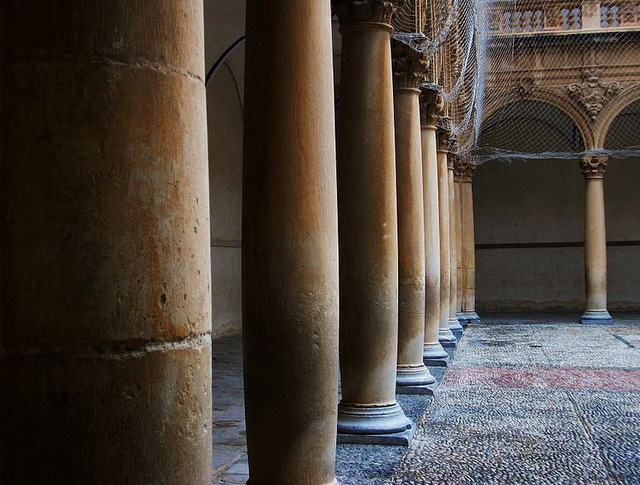 human characteristics, and there are also birds and heraldic symbols.
human characteristics, and there are also birds and heraldic symbols.
The Colegio and Church of Santo Domingo are open to the public from Tuesday to Saturday between 10.00 and 14.00 and from 17.00 to 20.00. On Sundays and public holidays opening hours are from 10.00 to 14.00. Admission is free of charge.
Address: Calle Adolfo Clavarana, s/n. The church and school are at the north-eastern end of the main pedestrian 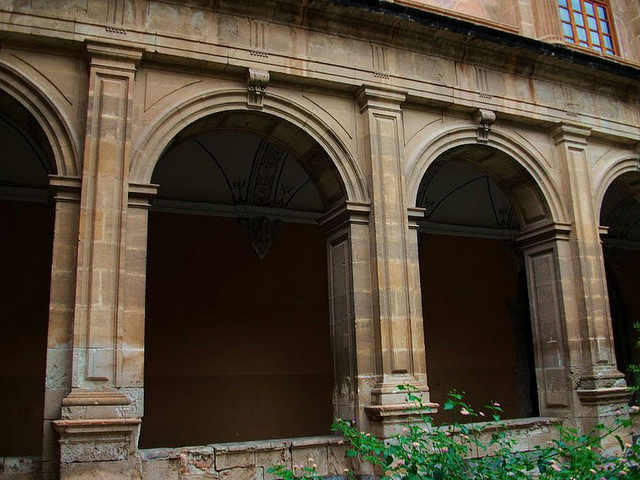 street which runs from the cathedral to the Puerta de la Olma, the eastern gate of the old city wall.
street which runs from the cathedral to the Puerta de la Olma, the eastern gate of the old city wall.
Tel: 965 300 249
Click for map, Calle Adolfo Clavarana

















